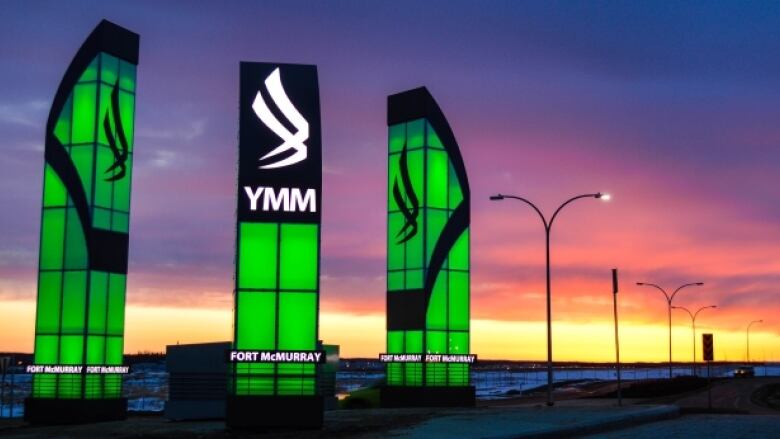COVID-19 another blow to passenger traffic at Fort McMurray airport after years of decline
Analysis shows airport had seen fewer passengers, made less money for years prior to COVID-19 pandemic

The COVID-19 pandemic tightened the squeeze on the Fort McMurray International Airport, which had already been seeing fewer passengers travelthrough its gates for several years.
A slowdown in construction, multiple natural disasters and a steep drop in population have all impacted operations of the Fort McMurray International Airport, according to officials from the northern Alberta community.
"We've taken it on the chin," said Roelof-Jan (R.J.)Steenstra, president and CEO of the Fort McMurray Airport Authority.
CBC News analyzed publicly available passenger data for the Fort McMurray airport from 2006 to June 2021 the most recent data available and its reported revenue and net incomes from fiscal 2010 to 2020.
Turbulence from COVID-19
Just over 595,300 passengers travelled through Fort McMurray International Airport in 2019, marking the fifth straight year where passenger traffic at the airport declined. The total was also less than half the roughly 1.3 million passengers from 2014.
The airport made over $28.6 million during fiscal 2019 and posted a net loss of nearly $2 million. Over half of the revenuewas made from passengers through airport improvement fees or parking and concessions, according to the 2019 annual report.
The first two months of 2020 were steady. But the declaration of the COVID-19 pandemic in mid-March resulted in traffic dropping immediately by about one-third before plunging again in April and May when public health restrictions nearly grounded travel.
For those two months, Fort McMurray's passenger traffic was down by 90 per cent from the beginning of the year.
Early in the pandemic, Fort McMurray fared relatively better than the Calgary and Edmonton airports which were operating at about five per cent capacity because rotational workers were flying in for shifts, said Steenstra.
"It gave us a base level of traffic that obviously was significantly down from pre-COVID levels but it allowed us to continue operating at a minimum level where other airports basically went to zero traffic," he said.
In the last year, things have improved slightly, with traffic fluctuating between 25 and 33 per cent of pre-pandemic capacity.
Just over 229,300 people travelled through the airport in 2020, the fewest number of passengers since 2003. The airport made over $14.2 million duringfiscal 2020, but reported a net loss of nearly $16 million, the annual report says.
The airport cut its operating costs by over 10 per cent, worked with tenants such as Tim Hortons to keep them operational and tweaked long-term capital plans. But there were no layoffs, said Streenstra.
The Regional Municipality of Wood Buffalo approved a $15-million grant for the airport in June to help with the financial impact of the pandemic. That money is to ensure the long-term operations of the airport, which is a huge economic driver for the community, Steenstra said.
"It simply is not feasible, nor can it be contemplated, that the airport wouldn't be sustainable going forward," he said.
Airport traffic decreasing since 2014
The airport reached a true pivot point in 2014.
The 1.3 million people who flew through the Fort McMurray airport that year was nearly double the number from 2009, and marked five consecutive years of growth.
That trend ended in 2015 and fewer people have flown through Fort McMurray every year since.
Passenger traffic dropped by more than 200,000people in 2015. Four years later, it was down to just over 595,300 the lowest since 2006, data shows.
Revenue dropped from $46.1 million in 2014 to about $28.6 million in 2019.
Steenstra and Tany Yao, United Conservative MLA for Fort McMurray-Wood Buffalo, mostly blame completed construction projects and the 2016 wildfire.
"It was just a bunch of things all at once," Yao said.
Many people were travelling to Fort McMurray at the end of the 2000s and early 2010s because oil projects were being built. But when the projects wrapped up, the large construction crews were replaced by much smaller contingents of employees, he said.
The number of people living at work camps increased from about 23,300 in 2010 to nearly 39,300 in 2012, according to publicly available census reports from the Regional Municipality of Wood Buffalo.
There was a slight decrease to about 38,300 people in 2015, which dropped even further to 32,900 by 2018, reports show.
A recession in 2015 impacted oil prices, and rumours of a potential carbon tax leading up to that year's federal election discouraged investing in more projects, Yao said.
He said some rotational workers commuted using their company's private fleet landing at private airstrips. Some jobs have meanwhile moved to larger centres, according to Yao.
Each of those factors resulted in fewer people travelling through the Fort McMurray airport, he said.
'The Beast'
May 2016 brought a massive wildfire which became known as "The Beast."
The airport stayed open to manage the evacuation and return of residents, as well as to support firefighting aircraft. But passenger traffic dropped over 85 per cent in May 2016.
Traffic rose to normal levels in July, data shows.
Nearly 745,000 passengers travelled through the airport by the end of 2016 a decrease of over 350,000 from the previous year.
Despite years of ups and downs, those at the Fort McMurray International Airport are hopeful things will bounce back.
Rising vaccination rates and loosening travel restrictions are optimistic signs of more passengers to come, Steenstra said, though it will take time to re-establish routesand business travel might be slow to return.
The airport's 2020 annual report predicts it will take three to five years before operations reach pre-pandemic levels.
"It's a tough situation, but we're glass-half-full kind of people up here and we're optimistic about the future and what it holds for the community," Steenstrasaid.












_(720p).jpg)


 OFFICIAL HD MUSIC VIDEO.jpg)
.jpg)



























































































